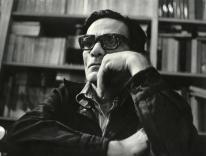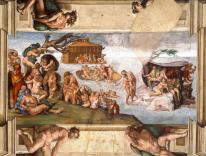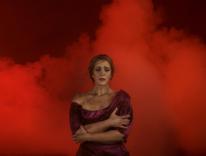A photograph often tells more about who was behind the camera than what lies in front of it. From its invention in 1839 in the workshops of Louis Daguerre and Fox Talbot, photography has generally succeeded in giving the impression that it conveys complete accuracy and the unadorned truth. Yet every photograph is the result of specific choices made by the one behind the camera before the shutter opens and closes, and now, increasingly, during the editing and production processes. To really “see” a photograph, therefore, it is critical to know both the photographer and what is involved in the process.
The current exhibition at the Getty Villa in Malibu, California, “In Search of Biblical Lands: From Jerusalem to Jordan in Nineteenth-century Photography,” is a revealing study of more than a hundred early photographs from the Holy Land. It stimulates appreciation for photography as an art, but also reveals the camera’s ability to conjure nostalgia and illusion, as well as instruct and editorialize. The exhibit will be on display through September 12, with half of the photographs rotating midway through the run to protect them from light damage.
From the 1840s to the early 1900s, European and American visitors, mostly British and American Protestants, arrived as tourists in Palestine. These Westerners were initially hearty academics and ministers. Eventually entrepreneurs like Thomas Cook began to offer luxury tours for other “pilgrims” (a term Protestants were often ambivalent about). Those who arrived looking for the proverbial “shining city on a hill” quickly found their expectations dashed.
The Holy Land was no religious theme park. While the presuppositions of the visitors had been informed by preachers and romantic prints and maps (both topographic and historical) found in popular new “family Bibles,” Palestine itself was a squalid backwater in the failing Ottoman Empire. The dust of centuries of neglect and the stench of raw sewage permeated the streets of Jerusalem. One visitor, Frances Willard, wrote that “Jerusalem is the most disagreeable, dismal, ugly city I have ever seen.” For her, the Jerusalem of David, Solomon, and Christ was buried beneath the streets. Mark Twain, traveling with Rev. Henry Ward Beecher and members of his Congregationalist flock in 1867, gathered stones to hurl at Christians in his The Innocents Abroad. He reported that “of all the lands of dreary scenery, Palestine must be the prince.” Similarly, Rev. Andrew Thompson complained that, after entering Jerusalem through the Jaffe Gate, “the waking dreams of a lifetime” were erased by “the jabbering of custom-house officers eager for bribes.”
The holy places often proved disappointing, if not offputting. By European standards, the Holy Sepulcher itself was an unimpressive cavern, the haunt of peevish papists, Copts, and Orthodox clergy. The Franciscans had even gone so far as to turn the Garden of Gethsemane into a formal Tuscan garden.
Accosted by these wretched scenes, pilgrims turned to the camera to protect or reinforce their faith. And it proved to serve this purpose very well. The Getty exhibit, curated by Kathleen Stewart Howe, tells the story and presents a wide range of early photographs. They include haunting images of people, shrines, and ancient fortresses, as well as the stunning, if often spare, beauty of the biblical lands.
The camera arrived in Palestine in 1840, within a year of the invention of the daguerreotype. E. G. Robinson, one of the first academics to find his way from Cairo to Jerusalem, traveled on camelback with his camera and constantly worried about brigands. Soon, professional photographers in the business of providing pilgrims with a visible record of what they had “seen” set up shops to serve the tourist trade. The Getty photos include daguerreotypes, salted-paper prints, and albumen silver prints by Félix Bonfils (1831–85), Joseph-Philibert Girault de Prangey (1804–92), Francis Frith (1882–98), and many others. The photos, drawn from the extensive Getty collections, include beautifully composed chiaroscuro views of Jerusalem, Bethlehem, Nazareth, Jaffa, and Petra, and posed scenes of the locals that depicted Palestine as if it had not changed since biblical times. (One is reminded of the photographs of Edward S. Curtis [1868–1952] and his recreation of North American Indian life.) Many of the photographs on display combine remarkable technical quality with a keen interest in conveying the history and beauty of the region.
But perhaps even more interesting than the photos themselves is what they tell us about the photographers. European and American Christians, especially Protestants, felt the need to construct a worthy Holy Land for themselves and their coreligionists from the base material they found in Ottoman Palestine. The writer Henry van Dyke, initially fearful that the dust and squalor might prove corrosive to his faith, came to the consoling conclusion that the Holy Land only needed to be reframed in such a way that pilgrims could put in perspective what they had seen. “The conventions of travel,” he noted, “do not always correspond to the realities of the heart.” Palestine’s photographers used their cameras to capture these “realities of the heart.” E. G. Robinson reported that he was beholding with his own eyes what he had known from childhood and that these sights “all seemed familiar...as if the realization of a former dream.” It was this vision that Robinson and the photographers who followed him hoped to convey. As a result, Presbyterians returned home having seen and photographed a Presbyterian Holy Land, while Catholics and Baptists did likewise.
Many of the photographs in the exhibit are posed shots. (Exposure times for the early cameras precluded most “candid” shots.) The photographers, carrying bulky equipment, large cameras, and tripods, were attempting to photograph the Holy Land as it had been in biblical days. The local people might have seemed dirty and backward, but they were useful as props in reconstructing the biblical scenes. Bonfils’s Bearded Man is an Arab whose expansive beard and deep-set features suggest Michelangelo’s Moses. Lepers were also a very popular subject in the portfolios of these early photographers. One photo presents a group of lepers, arranged with exquisite grace, the ravages of Hansen’s disease engraved on their faces and hands. Compare this shot with the candid if amateurish photographs taken at the Kalaupapa leper colony in Hawaii, in roughly the same period. A photograph of the dusty village of Jerusalem in 1858 by Francis Frith gives the impression of the biblical city on a hill. Peasant women are photographed veiled, barefoot, and carrying bundles on their heads, just as Mary might have appeared in Nazareth.
Protestant visitors were not too interested in the traditional holy places. That’s because they thought many had been ruined by an overlay of postbiblical shrines and monasteries. Instead, travel guides led Protestants to the roads Jesus had traveled and to the hills he had climbed. Old Testament sites were popular too: the pool of Hezekiah, the Jewish cemetery in the Kidron, Jacob’s well at Shechem. Protestants also discovered their own holy places. An arch located by E. G. Robinson became a Protestant alternative to the Temple Mount and the Wailing Wall, to which access was sometimes restricted. General Charles Gordon (of Khartoum fame), his Evangelical belief thoroughly offended by a visit to the Holy Sepulcher, discovered a new site for Christ’s burial, the “Garden Tomb” near the Damascus Gate. Protestants continued to venerate it, even though there is overwhelming archeological evidence it could not have been Jesus’ tomb. Meanwhile, the local photographers were happy to oblige visitors with whatever pictures they wanted to buy.
The camera’s authority also helped remove the thorn that historical-critical biblical studies had lodged in the side of some literalist Protestants. The images managed to promote the Holy Land as a “fifth Gospel,” which in turn offered “scientific” verification of traditional belief. Robinson, for example, was confident that “the Holy Land would provide a tangible, empirical counterpart to the infallible text of the Bible.” In addition to the deposit of faith found in Scripture, this “fifth Gospel” offered a material, scientifically accessible revelation of divine truth. Archeological and geographic studies of the Holy Land could now be presented and accompanied with photographic evidence to refute modern skeptics.
The pieces on display at the Getty remind us that visitors have always found a way to see what they wanted to see in Palestine and, in doing so, have claimed it as their own.
Please email comments to [email protected] and join the conversation on our Facebook page.
Share
Previous Story
Outside Gravity
Next Story
Engerland


